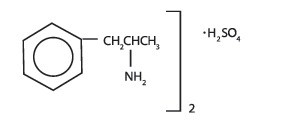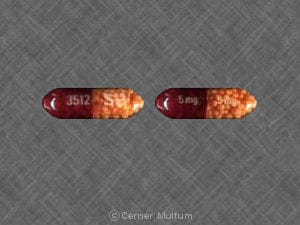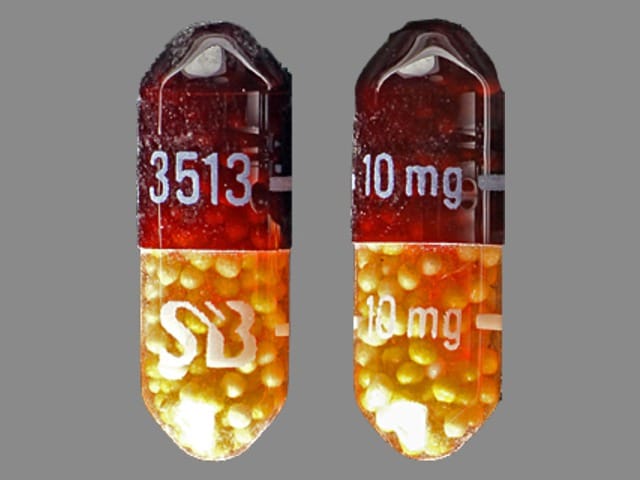Dexedrine
Generic name: dextroamphetamine
Brand names: Dexedrine Spansule, ProCentra, Zenzedi
Drug class: CNS stimulants
Medically reviewed by A Ras MD.
What is Dexedrine?
Dexedrine is a central nervous system stimulant prescription medicine. It is used for the treatment of Attention-Deficit Hyperactivity Disorder (ADHD).
Dexedrine may help increase attention and decrease impulsiveness and hyperactivity in patients with ADHD. Dexedrine should be used as a part of a total treatment program for ADHD that may include counseling or other therapies. Dexedrine is also used in the treatment of a sleep disorder called narcolepsy.
Dexedrine is a federally controlled substance (CII) because it can be abused or lead to dependence. Keep Dexedrine in a safe place to prevent misuse and abuse. Selling or giving away Dexedrine may harm others, and is against the law. Tell your doctor if you or your child have (or have a family history of) ever abused or been dependent on alcohol, prescription medicines or street drugs.
Description
DEXEDRINE (dextroamphetamine sulfate) is the dextro isomer of the compound d,l-amphetamine
sulfate, a sympathomimetic amine of the amphetamine group. Chemically, dextroamphetamine is d-alpha-methylphenethylamine, and is present in all forms of DEXEDRINE as the neutral sulfate.
Structural formula:

SPANSULE capsules
Each SPANSULE sustained-release capsule is so prepared that an initial dose is released promptly and the remaining medication is released gradually over a prolonged period.
Each capsule, with brown cap and natural body, contains dextroamphetamine sulfate. The 5-mg capsule is imprinted in white with IX and 5 mg on the brown cap and is imprinted in white with 673 and 5 mg on the natural body. The 10-mg capsule is imprinted in white with IX and 10 mg on the brown cap and is imprinted in white with 674 and 10 mg on the natural body. The 15-mg capsule is imprinted in white with IX and 15 mg on the brown cap and is imprinted in white with 675 and 15 mg on the natural body. Product reformulation in 1996 has caused a minor change in the color of the time-released pellets within each capsule. Inactive ingredients now consist of cetyl alcohol, D&C Yellow No. 10, dibutyl sebacate, ethylcellulose, FD&C Blue No. 1, FD&C Red No. 40, FD&C Yellow No. 6, gelatin, hypromellose, polyethylene glycol, povidone, sodium lauryl sulfate, sugar spheres, and trace amounts of other inactive ingredients.
What is the most important information I should know about Dexedrine?
The following have been reported with use of Dexedrine and other stimulant medicines.
1. Heart-related problems:
- Sudden death in patients who have heart problems or heart defects
- Stroke and heart attack in adults
- Increased blood pressure and heart rate
Tell your doctor if you or your child have any heart problems, heart defects, high blood pressure, or a family history of these problems.
Your doctor should check you or your child carefully for heart problems before starting Dexedrine.
Your doctor should check your or your child’s blood pressure and heart rate regularly during treatment with Dexedrine.
Call your doctor right away if you or your child has any signs of heart problems such as chest pain, shortness of breath, or fainting while taking Dexedrine.
2. Mental (Psychiatric) problems:
All Patients
- new or worse behavior and thought problems
- new or worse bipolar illness
- new or worse aggressive behavior or hostility
Children and Teenagers
- new psychotic symptoms (such as hearing voices, believing things that are not true, are suspicious) or new manic symptoms
Tell your doctor about any mental problems you or your child have, or about a family history of suicide, bipolar illness, or depression.
Call your doctor right away if you or your child have any new or worsening mental symptoms or problems while taking Dexedrine, especially seeing or hearing things that are not real, believing things that are not real, or are suspicious.
3. Circulation problems in fingers and toes [Peripheral vasculopathy, including Raynaud’s phenomenon]:
- fingers or toes may feel numb, cool, painful
- fingers or toes may change color from pale, to blue, to red
Tell your doctor if you have or your child has numbness, pain, skin color change, or sensitivity to temperature in your fingers or toes.
Call your doctor right away if you have or your child has any signs of unexplained wounds appearing on fingers or toes while taking Dexedrine.
Who should not take Dexedrine?
Dexedrine should not be taken if you or your child:
- Have heart disease or hardening of the arteries
- Have moderate to severe high blood pressure
- Have hyperthyroidism
- Have an eye problem called glaucoma
- Are very anxious, tense, or agitated
- Have a history of drug abuse
- Are taking or have taken within the past 14 days an antidepression medicine called a monoamine oxidase inhibitor or MAOI.
- Is sensitive to, allergic to, or had a reaction to other stimulant medicines
Dexedrine is not recommended for use in children younger than 6 years old.
What should I tell my healthcare provider before taking Dexedrine?
Dexedrine may not be right for you or your child. Before starting Dexedrine tell your or your child’s doctor about all health conditions (or a family history of) including:
- Heart problems, heart defects, high blood pressure
- Mental problems including psychosis, mania, bipolar illness, or depression
- Tics or Tourette’s syndrome
- Thyroid problems
- Seizures or have had an abnormal brain wave test (EEG)
- Circulation problems in fingers and toes
Tell your doctor if you or your child is pregnant, planning to become pregnant, or breastfeeding.
Can Dexedrine be taken with other medicines?
Tell your doctor about all of the medicines that you or your child take including prescription and non-prescription medicines, vitamins, and herbal supplements. Dexedrine and some medicines may interact with each other and cause serious side effects. Sometimes the doses of other medicines will need to be adjusted while taking Dexedrine.
Your doctor will decide whether Dexedrine can be taken with other medicines.
Especially tell your doctor if you or your child takes:
- Anti-depression medicines including MAOIs
- Blood pressure medicines
- Antacids
- Seizure medicines
Know the medicines that you or your child takes. Keep a list of your medicines with you to show your doctor and pharmacist.
Do not start any new medicine while taking Dexedrine without talking to your doctor first.
How should I take Dexedrine?
- Take Dexedrine exactly as prescribed. Your doctor may adjust the dose until it is right for you or your child.
- Dexedrine comes as a capsule.
- Dexedrine Spansule capsules are usually taken once a day in the morning. Dexedrine Spansule is an extended-release capsule. It releases medicine into your body throughout the day.
- From time to time, your doctor may stop treatment with Dexedrine for a while to check ADHD symptoms.
- Your doctor may do regular checks of the blood, heart, and blood pressure while taking Dexedrine. Children should have their height and weight checked often while taking Dexedrine. Treatment with Dexedrine may be stopped if a problem is found during these check-ups.
- If you or your child takes too much Dexedrine or overdoses, call your doctor or poison control center right away, or get emergency treatment.
What are possible side effects of Dexedrine?
See “What is the most important information I should know about Dexedrine?” above for information on reported heart and mental problems.
Other serious side effects include:
- Slowing of growth (height and weight) in children
- Seizures, mainly in patients with a history of seizures
- Eyesight changes or blurred vision
Common side effects include:
- Fast heart beat
- Decreased appetite
- Tremors
- Headache
- Trouble sleeping
- Dizziness
- Stomach upset
- Weight loss
- Dry mouth
Dexedrine may affect your or your child’s ability to drive or do other dangerous activities.
Talk to your doctor if you or your child has side effects that are bothersome or do not go away.
This is not a complete list of possible side effects. Ask your doctor or pharmacist for more information. Call your doctor for medical advice about side effects. You may report side effects to FDA at 1-800-FDA-1088.
General information about the safe and effective use of Dexedrine
Medicines are sometimes prescribed for purposes other than those listed in a Medication Guide. Do not use Dexedrine for a condition for which it was not prescribed. Do not give Dexedrine to other people, even if they have the same condition. It may harm them and it is against the law.
This Medication Guide summarizes the most important information about Dexedrine. If you would like more information, talk with your doctor. You can ask your doctor or pharmacist for information about Dexedrine that was written for healthcare professionals. For more information about Dexedrine, please contact Amneal Pharmaceuticals at 1-877-835-5472 or visit www.amneal.com.
How should I store Dexedrine?
- Store Dexedrine Spansule capsules in a safe place at room temperature, 68° to 77°F (20° to 25°C). Protect from light.
- Keep Dexedrine and all medicines out of the reach of children.
What are the ingredients in Dexedrine?
Active Ingredient: Dextroamphetamine sulfate
Inactive Ingredients: Cetyl alcohol, D&C Yellow No. 10, dibutyl sebacate, ethylcellulose, FD&C Blue No. 1, FD&C Red No. 40, FD&C Yellow No. 6, gelatin, hypromellose, polyethylene glycol, povidone, sodium lauryl sulfate, sugar spheres and trace amounts of other inactive ingredients.
Label
PRINCIPAL DISPLAY PANEL – 5 MG CARTON


PRINCIPAL DISPLAY PANEL – 10 MG BOTTLE LABEL


